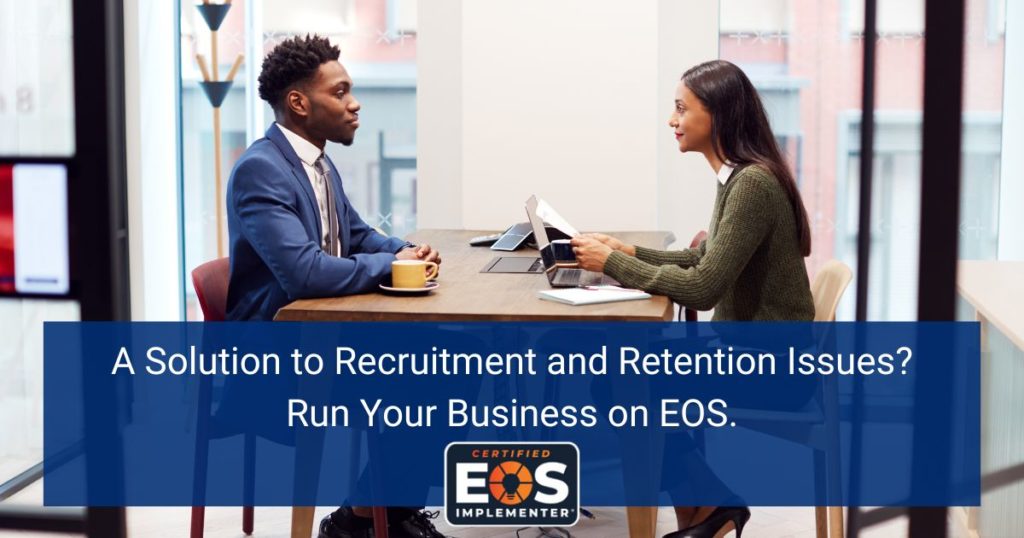At the end of every session, I ask my clients to share an “a-ha” moment from the day. One of my clients responded with, “Resolving ‘Right People Right Seats’ (or RPRS) solved a lot of issues and eased a lot of pain.”
As an EOS implementer, I’ve worked with all kinds of businesses, from manufacturers to marketers. What makes EOS effective across all these industries? It deals with an aspect that’s the same within every business: people.
Your company, no matter the size or the industry, can’t run without people to keep it going. In today’s unpredictable economy, the last thing you need to worry about is recruitment and retention. Solve issues, keep business running smoothly, and get the right people in the right seats with EOS.
Culture Fit is Key
You know the saying, “if you don’t love yourself, how can you love someone else?” The same thing could be said about your company’s core values. In their simplest form, your core values represent who you are as an organization.
When first thinking about core values, people tend to think more of goals aspirations or things they want to be when in reality it’s not truly who they are. Think of your personal values – they are essentially the reason you make every decision you make, they define you and how you live your life.
Core values should be the same way within your business. Discovering your company’s true core values will attract the right people to you, strengthening your business and unlocking new growth and opportunities. What are the values your company lives by? How do you live them every day?
There is no better way to attract the right people to your business than by having clearly defined core values. These values, once defined, need to be understood by—and reflected in—everyone on your team. If you remain true to your core values, you’ll be able to build a resilient team that’s in it for the long haul.
Getting the Right People in the Door
Getting the right person into the right seat can seem impossible when you’re having issues getting people to apply at all. However, we’ve all been in a candidate’s shoes—looking for a place to work that’ll treat you like a valuable and irreplaceable member of their team.
When your company runs on EOS, you’re showing prospective employees that your business is continually looking for ways to improve and grow. You can demonstrate this to applicants by:
- Sharing your company’s proven process
- Sharing your core values and core focus
- Having clearly defined accountability chart roles
- Include open-ended questions in the hiring process to determine if the candidate fits your core values
How to Get People in the Right Seats
Hiring and recruitment is only half the battle. Once you have filled all the seats in your accountability chart, it’s important to keep them filled with the right people.
According to the Society for Human Resource Management (SHRM), companies spend between 50-75% of an employee’s annual salary to recruit and train someone new. This means that replacing 10 members of your team at an average salary of $60,000 per year, would cost a business $300,000 – $450,000 annually! Aside from the overall headache of training and onboarding, having constant turnover can reflect poorly on your company.
Not sure how to make sure you have the right people in the right seats? Just like almost everything with EOS, there are tools for that! Two handy tools that can help you get crystal clarity about the people in your team are The People Analyzer Tool and GWC (Get it, Want it, Capacity to Do It).
The People Analyzer
This tool is not only great for potential new employees, but for existing ones as well. With this one, we kept it simple—people are evaluated by your leadership team with a “+”, “-”, or “+/-” on how well they fit your company’s core values. These are defined by:
- + means they live the core value “most of the time” – no one is perfect
- +/- means they “sometimes do sometimes don’t” live the core value – they’re hot and cold
- – means that “most of the time” they do not live that core value
This tool requires you to be honest with yourself and trust your gut. In this process, you’re creating awareness and exposing issues, giving you a clear picture of who is right for your team.
Pro-tip: To make the most of this tool, I recommend you establish a minimum number of pluses or plus-minuses an employee needs to have to be considered a “fit” for your team.
The Get It, Want It, Capacity to Do It (GWC)
Having clearly defined roles and responsibilities for each seat in your accountability chart ensures that each person gets it, wants it, and has the capacity to do it. However, when it comes to people, emotions often come into play, which can make things uncomfortable.
By bringing your people’s issues to the GWC tool, you’re leaving feelings out of it by keeping it professional. This evaluation can be done quickly by asking the following questions:
-
- Do they Get it? Do they understand their role and responsibilities? Does it come naturally to them?
- Do they Want it? Are they putting in full effort? Do they care about the work they’re doing? Do they have a positive attitude while at work?
- Do they have the Capacity/capability to do it? Do they have the right mental, physical, and emotional ability? Do they have the time they need to do the job well?
Pro-tip: It’s important to answer these questions honestly. Whether you’re evaluating a long-time employee that’s no longer working out, or desperate to fill an empty position, putting the wrong person in the wrong seat only sets you and your business back.
Running on EOS can help your business in a variety of ways, including retention and hiring. Want to learn more about what else it can do for you? Contact me to schedule a free 90-minute consultation!



